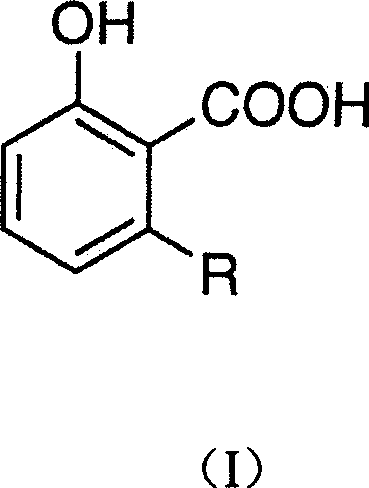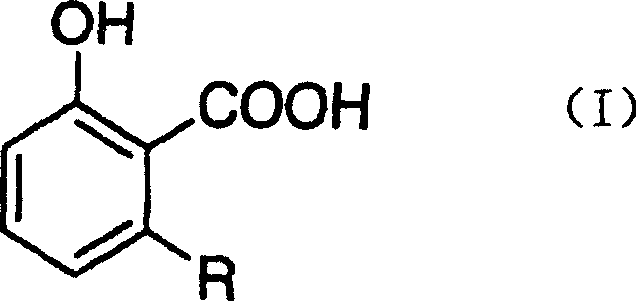Use of ginkgoic acid in preparation of biological pesticide for killing Oncomelania snail and preventing schistosomiasis
A technology for biological pesticides and schistosomiasis, applied in the directions of biocides, chemicals for biological control, biocides, etc., can solve the problems of high price, harm, environmental pollution, etc., and achieve the effect of preventing schistosomiasis
- Summary
- Abstract
- Description
- Claims
- Application Information
AI Technical Summary
Problems solved by technology
Method used
Image
Examples
Embodiment 1
[0035] Example 1 The effect of ginkgolic acid (C13:0) component on killing snails
[0036] 1. Extraction of ginkgolic acid:
[0037] Add 100g of dried and crushed Ginkgo testa, add petroleum ether (boiling range 60-90°C) in a ratio of 1:5 for ultrasonic extraction for 1 hour, filter, repeat the extraction of the filter residue twice, combine the extractions, and evaporate the petroleum ether to obtain the exocarp. Skin crude extract extract.
[0038] The extract was dissolved in a small amount of petroleum ether and loaded onto a silica gel column (120 g of silica gel, the silica gel column was a glass column of Φ32×400 mm, wet-packed), using petroleum ether: ether: formic acid = 89: 11: 1 ( V / V / V) elution, with thin-layer chromatography appearing fluorescence at 254nm as detection, collect the ginkgolic acid components, concentrated to dryness; repeat the column once, the obtained ginkgolic acid components were washed to neutral, concentrated to dry, or with anhydrous Na 2...
Embodiment 2
[0051] Example 2 The effect of ginkgolic acid (C15:1) component on killing snails
[0052] 1. Extraction of ginkgolic acid (C15:1):
[0053] Dissolve the extract of the above-mentioned testa crude extract with a small amount of petroleum ether and apply it on a silica gel column (120 g of silica gel, the silica gel column is a glass column of Φ32 × 400 mm, packed by wet method), and use petroleum ether: ether: formic acid=89 : 11:1 (V / V / V) elution, detected by the appearance of fluorescence at 254nm in thin-layer chromatography, collecting the fraction with the largest spot among them, and concentrating to dryness to obtain the ginkgolic acid (C15:1) fraction.
[0054] 2. Analysis and purity determination (reversed-phase HPLC method):
[0055] The 15cm C18RP-HPLC column is used in conjunction with the 20cm silver-loaded cation HPLC exchange column, with methanol: water=93: 7 (acidified with 0.1% formic acid) as mobile phase, and the ultraviolet detection wavelength is 311nm, ...
Embodiment 3
[0065] Example 3 Killing effect of Ginkgo biloba exotesta crude extract extract on Oncomelania snails
[0066] 1. Preparation of ginkgo testa crude extract:
[0067] Add 100g of dried and crushed Ginkgo testa, add petroleum ether (boiling range 60-90°C) in a ratio of 1:5 for ultrasonic extraction for 1 hour, filter, repeat the extraction of the filter residue twice, combine the extractions, and evaporate the petroleum ether to obtain the exocarp. Skin crude extract extract.
[0068] 2. Analysis of the content of ginkgolic acid in the crude extract of Ginkgo biloba testa (reversed-phase HPLC method):
[0069] Measured by the above-mentioned RP-HPLC method, the content of total ginkgolic acid in the crude extract of ginkgo testa is 5.46%.
[0070] 3. The effect of soaking the extract of ginkgo testa crude extract to kill oncomelania:
[0071] The above-mentioned Ginkgo biloba exotesta crude extract was dissolved with a small amount of absolute ethanol, and then diluted with b...
PUM
 Login to View More
Login to View More Abstract
Description
Claims
Application Information
 Login to View More
Login to View More - R&D
- Intellectual Property
- Life Sciences
- Materials
- Tech Scout
- Unparalleled Data Quality
- Higher Quality Content
- 60% Fewer Hallucinations
Browse by: Latest US Patents, China's latest patents, Technical Efficacy Thesaurus, Application Domain, Technology Topic, Popular Technical Reports.
© 2025 PatSnap. All rights reserved.Legal|Privacy policy|Modern Slavery Act Transparency Statement|Sitemap|About US| Contact US: help@patsnap.com


